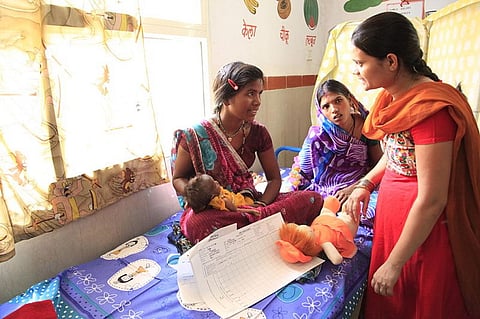Adolescent fertility rate, teenage pregnancies decline in Indian states: NFHS-5
The total fertility rate (TFR) declined across most Indian states, according to the latest National Family and Health Survey (NFHS). Adolescent fertility followed a similar declining trend, Meghalaya and Tripura being the exceptions.
As many as 20,000 girls under the age of 18 in developing countries give birth every day. If the adolescent pregnancies, which did not result in live births, are also included, this number is even higher.
Of the 22 surveyed states, Tripura recorded the highest adolescent fertility rate for women aged 15-19 years, with 69 births per 1,000 women aged 15-19.
The lowest adolescent fertility was recorded in Goa with 14 births per 1,000 women aged 15-19, and both Ladakh and Lakshadweep (among Union territories) with 2 births per 1,000 women aged 15-19.
Adolescent Fertility Rate
The United Nations defines adolescent fertility rate (AFR) as the annual number of births to women aged 15-19 years per 1,000 women. Adolescent pregnancy in India has seen quite a change in the past decade. Although there has been a steady decline in India’s adolescent fertility rate, it is a cause of concern still, especially since India will continue to have one of the youngest populations in the world till 2030.
Most states saw a decline in adolescent fertility rates. However, Meghalaya saw an increase in AFR from 48 to 49 births per 1,000 women aged 15-19 and Tripura saw an increase from 82 to 91 births per 1,000 women aged 15-19.
This could be attributed to an increase in the percentage of women aged 20-24 who were married before 18. According to NFHS-4, more than half (52 per cent) of currently married women between 15 and 19 years have already begun childbearing.
With the increasing number of married adolescents, the adolescent fertility rate is most likely to increase as well.
According to the NFHS-5 factsheets, the percentage of women aged 20-24 who were married before 18 increased in Assam, Manipur and Tripura; Meghalaya and West Bengal did not undergo any change.
These are also the states with high AFRs — more than 42 births per 1,000 women aged 15-19 years.
Bihar, Manipur and Sikkim saw no change in their adolescent fertility rates. This is a cause of concern, especially in Bihar and Manipur where the AFRs are as high as 77 and 43 births per 1,000 women aged 15-19 respectively.
The highest decline in AFR was registered in Nagaland where the AFR fell from 42 to 19 births per 1,000 women aged 15-19, followed by Telangana where AFR fell from 67 to 48 births per 1,000 women aged 15-19 years.
Regional differentials in AFR
Although adolescent fertility in the surveyed states follows a similar pattern, the AFR differentials were quite high.
Adolescent fertility was the highest in the north-eastern states of India, except Nagaland. While Tripura and West Bengal had AFR higher than 80 births per 1,000 women aged 15-19, Assam and Bihar also record high AFRs in the range of 60-80 births per 1,000 women aged 15-19 years.
The surveyed north Indian states of Himachal Pradesh, Jammu and Kashmir and Ladakh showed low adolescent fertility rates (less than 23 births per 1,000 women aged 15-19 years). On the other hand, the central states (Maharashtra) and south Indian states (Telangana, Karnataka, Andhra Pradesh) record high AFRs in the range of 40-60 births per 1,000 women aged 15-19 years.
The only south Indian state which recorded low AFR was Kerala with 18 births per 1,000 women aged 15-19 years.
Tripura (21.9 per cent); West Bengal (16.4 per cent); Andhra Pradesh (12.6 per cent); Assam (11.7 per cent); and Bihar (11 per cent) had higher levels of teenage pregnancy than other surveyed states and UTs.
The battle against teenage pregnancies can only be overcome with the help of the community. Parents, teachers, peers, and mentors need to be made aware of the causes and consequences of teenage pregnancies.
An understanding of sexual and reproductive health (SRH) is important in society. Several NGOs and volunteers such as ASHA/ANM members are working towards achieving this goal. These health workers have a substantial role in encouraging family planning services and curbing teenage pregnancies.
To enable adolescents to fulfil their potential and help them lead a safe life, significant investments must be made in education, health, and development, among others.


